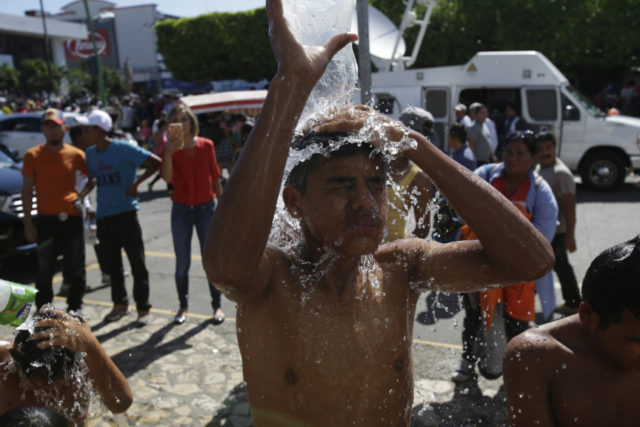TAPACHULA, Mexico (AP) — Thousands of Central American migrants resumed an arduous trek toward the U.S. border Monday, with members bristling at suggestions there could be terrorists among them and saying the caravan is being used for political ends by U.S. President Donald Trump.
The caravan’s numbers have continued to grow, and the United Nations estimated that it currently comprises some 7,200 people, “many of whom intend to continue the march north.”
However, they were still some 1,140 miles from the nearest border crossing — McAllen, Texas — and the length of their journey could double if they go to Tijuana-San Diego, as many did in another caravan earlier this year. That one shrank significantly as it moved through Mexico, and only a tiny fraction — about 200 of the 1,200 in the group — reached the border in California.
The same could well happen this time around as some turn back, splinter off on their own or decide to take their chances on asylum in Mexico.
While such caravans have occurred semi-regularly over the years, this one has become a particularly hot topic ahead of U.S. midterm elections in early November, and an immigrant rights activist traveling with the group accused Trump of using it to stir up his Republican base.
“It is a shame that a president so powerful uses this caravan for political ends,” said Irineo Mujica of the group Pueblo Sin Fronteras — People Without Borders — which works to provide humanitarian aid to migrants.
Some have questioned the timing so close to the vote and whether some political force was behind it, though by all appearances it began as a group of 160 who decided to band together in Honduras for protection and snowballed as the group moved north.
“No one is capable of organizing this many people,” Mujica said, adding that there are only two forces driving this: “hunger and death.”
Earlier in the day Trump renewed threats against Central American governments and blasted Democrats for what he called “pathetic” immigration laws.
In another tweet, he blamed Guatemala, Honduras and El Salvador for not stopping people from leaving their countries. “We will now begin cutting off, or substantially reducing, the massive foreign aid routinely given to them,” he wrote.
A team of AP journalists traveling with the caravan for more than a week has spoken with Hondurans, Guatemalans and Salvadorans, but has not met any Middle Easterners, who Trump suggested were “mixed in” with the Central American migrants.
It was clear though that more migrants were continuing to join the caravan.
Denis Omar Contreras, a Honduran-born caravan leader with the organization Pueblo Sin Fronteras — People Without Borders — said Trump should stop accusing the caravan of harboring terrorists.
“There isn’t a single terrorist here,” he said. “We are all people from Honduras, El Salvador, Guatemala and Nicaragua. And as far as I know there are no terrorists in these four countries, at least beyond the corrupt governments.”
The migrants, many of them with blistering and bandaged feet, left the southern city of Tapachula under a burning sun bound for Huixtla about 25 miles (40 kilometers) away.
Carlos Leonidas Garcia Urbina, a 28-year-old from Tocoa, Honduras, said he was cutting the grass in his father’s yard when he heard about the caravan, dropped the shears right there on the ground and ran to join with just 500 lempiras ($20) in his pocket.
“We are going to the promised land,” Garcia said, motioning to his fellow travelers.
Caravan leaders have not defined the precise route or decided where on the U.S. border they want to arrive, but in recent years most Central American migrants traveling on their own have opted for a more direct route that took them to Reynosa, across the border from McAllen.
The caravan is likely to lose its cohesiveness as it gets deeper into Mexico as groups traveling at different rates split off, turn back or decide to stay in Mexico.
It was clear Monday, though, that for now it was still growing as migrants rushed to catch up overnight.
In interviews along the journey, migrants have said they are fleeing widespread violence, poverty and corruption in Honduras. The caravan is unlike previous mass migrations for its unprecedented large numbers and because it largely began spontaneously through word of mouth.
José Anibal Rivera, 52, an unemployed Honduran security guard from San Pedro Sula crossed into Mexico by raft Sunday and walked up to Tapachula from Ciudad Hidalgo to join the caravan.
“There are like 500 more people behind me,” he said.
He vowed to reach the U.S. border. “Anything that happens, even if they kill me, is better than going back to Honduras,” he said.
Ana Luisa España, a laundress from Chiquimula, Guatemala, joined the caravan as she saw it pass through her country.
Even though the goal is to reach the U.S. border, she said: “We only want to work and if a job turns up in Mexico, I would do it. We would do anything, except bad things.”
Late Sunday, authorities in Guatemala said another group of about 1,000 migrants had entered that country from Honduras.
Civil defense officials for the southern Mexican state of Chiapas said they had offered to take the migrants by bus to a shelter about 5 miles (7 kilometers) outside Tapachula, but the migrants refused, fearing that if they boarded the buses they would be deported.
Ulises Garcia, a Red Cross official said some people with injuries from their hard trek refused to be taken to clinics or hospitals because they didn’t want to leave the caravan.
“We have had people who have ankle or shoulder injuries, from falls during the trip, and even though we have offered to take them somewhere where they can get better care, they have refused, because they fear they’ll be detained and deported,” Garcia said.

COMMENTS
Please let us know if you're having issues with commenting.